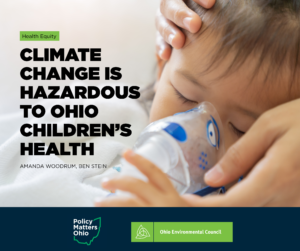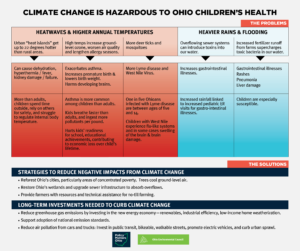Press Release
Tagged In: Air Pollution, clean air, Clean Energy, Clean Water, Climate Change, Drinking water, Energy Efficiency, Environmental Health, Federal Policy, Fossil Fuels, Fracking, Great Lakes, Green Energy, Green Living, Lake Erie, Land Use, Natural Resources, Ohio, Ohio Environmental Council, Ohio General Assembly, Parks & Forests, Policy Matters Ohio, Public Lands, Publications, State Policy, toxic algae, Water Pollution
Climate Change is Hazardous to Ohio Children’s Health
Emily Bacha, Vice President of Public Affairs, August 22, 2019
 A new report issued by Policy Matters Ohio and the Ohio Environmental Council documents how climate change harms the health of Ohio children. Policymakers at all levels of government can act now to stem climate change and protect the health of Ohio’s children.
A new report issued by Policy Matters Ohio and the Ohio Environmental Council documents how climate change harms the health of Ohio children. Policymakers at all levels of government can act now to stem climate change and protect the health of Ohio’s children.
“Climate change is already affecting the health of Ohio’s children, through extreme heat and precipitation, impacts on air quality, and changing patterns of infectious disease,” said Aparna Bole, a pediatrician in Cleveland and the American Academy of Pediatrics, Ohio Chapter.
Hotter days degrade air quality. This exacerbates asthma, which afflicts nearly one in 12 Ohio children, according to the American Lung Association’s 2019 State of the Air report. Heavy rains and flooding can contaminate public water supplies with bacteria, which is especially dangerous to children. Heavy rain coupled with warmer water temperatures can lead to harmful algal blooms, like the one in 2014 that contaminated tap water for nearly half a million people in and around the city of Toledo. Finally, insects thrive in warmer temperatures, which leads to more insect-borne diseases like Lyme disease. About one in five Ohioans with Lyme disease are between the ages of five and 14.
 Bole said, “The good news is, climate solutions that accelerate our transition to clean energy and transportation options all have immediate health benefits for Ohio’s kids. Our time to act on climate is now, for the sake of our kids’ current and future well-being.”
Bole said, “The good news is, climate solutions that accelerate our transition to clean energy and transportation options all have immediate health benefits for Ohio’s kids. Our time to act on climate is now, for the sake of our kids’ current and future well-being.”
Recent reports warn that we must substantially cut our greenhouse gas emissions within the next 12 years to avoid the most severe consequences to our planet and people.
“This is about our health and economic future of our kids,” said Heather Taylor-Miesle, executive director for the Ohio Environmental Council. “Ohio is well-positioned to lead and we must take steps to decarbonize our electric grid and strengthen regulations to cut methane emissions from oil and gas operations.”
The report notes that work to reduce the causes of climate change must go hand in hand with actions and policies that protect Ohio’s children from the present-day effects of climate change.
“Common-sense policy solutions at all levels of government can slow climate change and deal with its effects,” said Amy Hanauer, executive director of Policy Matters Ohio. “We can plant trees and preserve greenspace in urban areas to provide shade, absorb pollution and capture carbon. We should better fund transit and preserve greenfields to make our cities more vibrant and reduce reliance on cars. And getting rid of clean energy standards was a crazy approach – instead we need to do everything possible to increase conservation and use of wind and solar power. Other states are forging a path that we should get on to keep our kids healthy.”
The full report, Climate Change is Hazardous to Ohio Children’s Health, can be found here: http://bit.ly/ohiokids_climatechange.